
Back in the day when it was legal to hang a murderer or a rapist, an enterprising Nairobi-based court process server sensed he could make a killing by offering his services as a hangman.
Robert Marshal outsmarted other hangmen after he presented a tender of PS5 (Sh911) for every white person he hanged and ShPS1 (Sh140) for an African. He offered to hang Asians for free.
Marshal was not a pauper as another hangman Kirugumi Wanjuki, a prison warder at Kamiti who relied on begging in his retirement, despite claiming to have hanged field Marshal Dedan Kimathi.
Marshal had made a name in Nairobi social scene where he operated bars named Hoppy's along Ngong Road and in Nairobi's CBD which were patronised by the aristocratic playboys known for their love for alcohol, drugs and sex orgies during their Happy Valley parties.
From this venture, Marshal carted away money from his entertainment joints in sacks every night.
He provided free fish at the stroke of midnight in his bars. He was also into real estate where he made tidy profits selling land and other fixed assets.
It was impossible for Marshal to make millions from hanging. Government records indicate that between 1908 and 1956, only 459 convicted criminals had been hanged. This translates to an average of 9.5 hangs per year for 48 years.
These figures, according to Killing the Condemned: The Practice and Process of Capital Punishment in British East Africa 1900-1950s, excludes the executions carried out during the Mau Mau uprising.
Pioneer hangmen such as A Sellwood had been charging 75 Rupees for each criminal he hanged in 1912, when he occupied the office Public Executioner.
To make the job more attractive, Sellwood was entitled to second class rations and travelling allowances at a time trains were the main mode of travel. Expatriates during the colonial times were entitled to a paid trip back home for holidays.
After public hangings were banned in Kenya in 1922, whenever a criminal was being executed, his relatives and neighbours would be invited to visit the condemned prisoner in his cell and would later visit the facility after the hanging to ascertain their kin was no more.
Besides the hangman, a priest, prison superintendent and a doctor were supposed to witness as the subject was blindfolded, shackled, and a noose placed on his neck before he was led to the trap door.
Once the trapdoor was released, the prisoner was left suspended with the noose on his neck.
Stay informed. Subscribe to our newsletter
 The Standard Group Plc is a
multi-media organization with investments in media platforms spanning newspaper
print operations, television, radio broadcasting, digital and online services. The
Standard Group is recognized as a leading multi-media house in Kenya with a key
influence in matters of national and international interest.
The Standard Group Plc is a
multi-media organization with investments in media platforms spanning newspaper
print operations, television, radio broadcasting, digital and online services. The
Standard Group is recognized as a leading multi-media house in Kenya with a key
influence in matters of national and international interest.
 The Standard Group Plc is a
multi-media organization with investments in media platforms spanning newspaper
print operations, television, radio broadcasting, digital and online services. The
Standard Group is recognized as a leading multi-media house in Kenya with a key
influence in matters of national and international interest.
The Standard Group Plc is a
multi-media organization with investments in media platforms spanning newspaper
print operations, television, radio broadcasting, digital and online services. The
Standard Group is recognized as a leading multi-media house in Kenya with a key
influence in matters of national and international interest.






